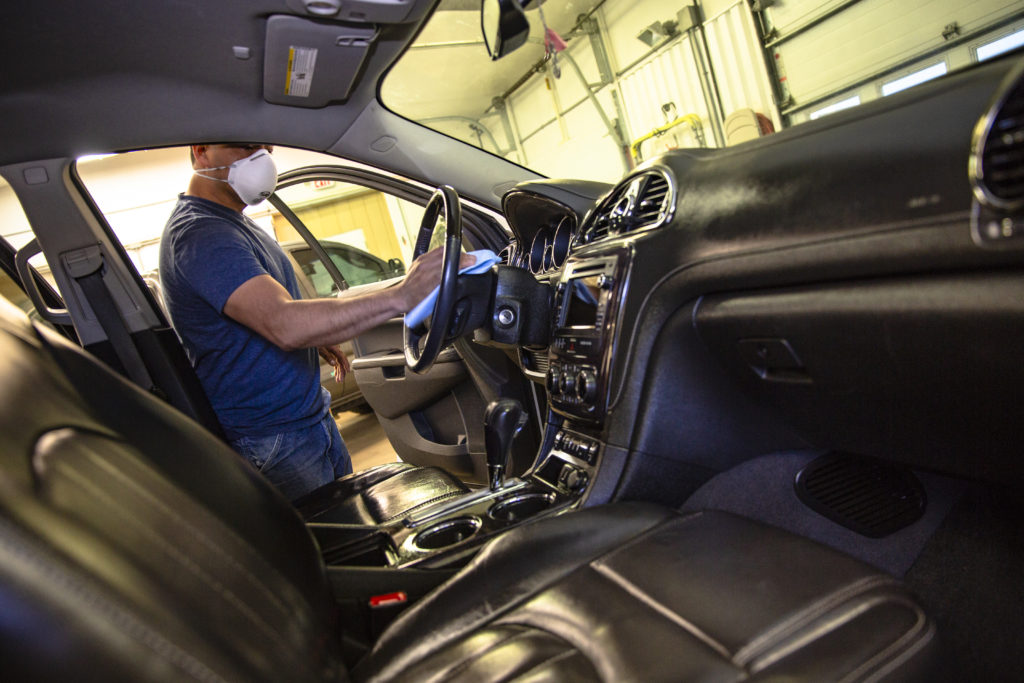How Can I Clean & Disinfect the Inside of My Car?

The average driver spends a lot of time inside their vehicle each week and some use it as their mobile office. Unfortunately, car interiors can be very dirty places where microorganisms thrive, including disease-causing bacteria and viruses. A recent study published by researchers from the UK’s University of Birmingham found that a children’s car seat may contain even more germs than the average toilet seat. To put your mind at ease, here are several reliable ways to clean and disinfect the inside of your car.
Where Do Germs Hide Inside a Car?
Your car’s passenger compartment has a lot of features that can easily double as hiding places for pesky germs, such as:
CABIN AIR FILTER
If you leave your windows rolled up most of the time, your cabin air filter probably contains a lot of trapped mold spores, pollen grains, and germs. But when that filter gets too dirty it can’t do its job, which will eventually lower your cabin’s air quality.
UPHOLSTERY
Carpet and seat upholstery attract food crumbs and other particles upon which bacteria and other microorganisms can grow. Door handles, dashboards, touch screens, shifters and steering wheels are typically covered in germs.
CAR KEYS
Your car keys are not only handled frequently, they also end up getting tossed on dirty surfaces that may contain numerous bacteria and viruses. When you pick those keys up the next morning, the germs hop on your skin.
These Germs Live Inside Vehicles
Some germs that can live inside your car may cause vomiting, diarrhea and coughing, while others make your throat sore or body ache. Here is a list of some of the more common germs that may be living inside your vehicle:
- Cold and flu viruses like rhinovirus and influenza
- Mold spores and allergens
- Intestinal organisms like E. Coli, salmonella and Norovirus
- Coronaviruses like COVID-19
How to Protect Your Vehicle’s Occupants
Fortunately, there are several preventative measures you can take that will help keep unwanted “passengers” out and your vehicle’s occupants safer, starting with these:
VACUUM
Give your vehicle’s interior a good vacuuming every month and be sure to use a brush attachment on the seat fabric and carpeting. Then, use a crevice tool to vacuum all the little nooks and crannies where food crumbs and bacteria congregate. Vacuum under the seats, between the seats and then be sure to thoroughly vacuum your child’s safety seat!
SHAMPOO
Microscopic particles like pollen, dust and germs can infiltrate deep inside your carpet and seat upholstery. That’s why it’s also important to shampoo your cabin’s cloth material from time-to-time. Shampooing the floor mats and then hanging them outside to dry in the sunlight will also act as a disinfectant. If you don’t have time for a DIY upholstery shampoo, many auto body shops offer professional interior detailing services for the average driver.
DISINFECT
Some harmful viruses can live for weeks on exposed plastic, vinyl and metal surfaces, so wipe down your dash, trim, cup holders, door panels and consoles with reliable disinfectant wipes. You may even want to use a highly effective disinfectant spray to clean the air inside your passenger compartment.
A/C & CABIN FILTERS
Your A/C and cabin filters are necessary to remove harmful particles from the passenger compartment, which means when they get clogged the air quality starts to diminish. Be sure to replace those filters based on the manufacturer’s recommendations found in your owner’s manual. A mechanic can also clean out your A/C vents for added protection.

